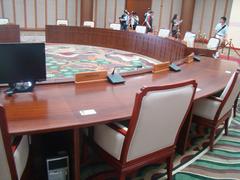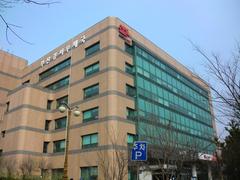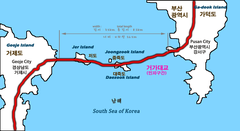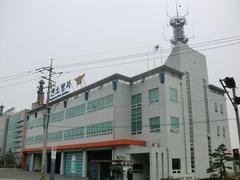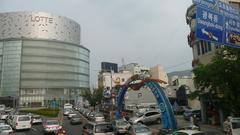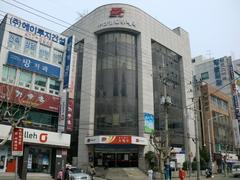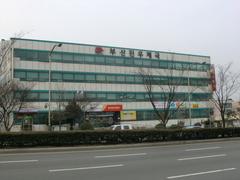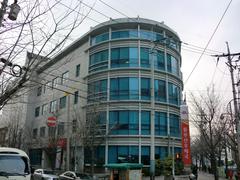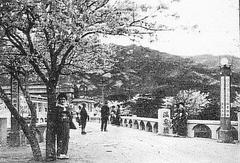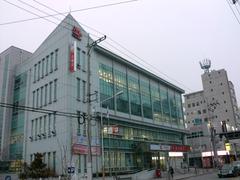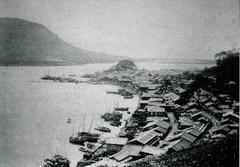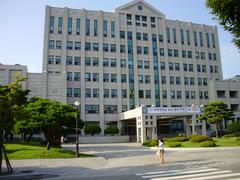Visiting Nampo Station, Busan, South Korea: Comprehensive Guide to Tickets, Hours, and Travel Tips
Date: 04/07/2025
Introduction: Nampo Station’s History and Significance
Nestled in Busan’s historic Jung District, Nampo Station is more than a transit hub—it is the gateway to Nampo-dong, Busan’s original downtown. This area, steeped in history and cultural vibrancy, showcases Busan’s evolution from a bustling port to a modern metropolis. “Nampo,” meaning “South Port,” underscores its long-standing role as a center for trade, culture, and urban development since the late 19th century. Visitors can experience the unique fusion of traditional markets such as Gukje Market and Jagalchi Fish Market alongside contemporary landmarks like BIFF Square, the heart of the Busan International Film Festival (Busanpedia).
Since its opening in 1987 as part of Busan Metro Line 1, Nampo Station has improved access to a wealth of attractions, including museums, shopping streets, and cultural events. Daily operations run from early morning to midnight, with convenient ticketing options such as T-money and Hanaro cards for seamless travel. The station is fully accessible, equipped with elevators, escalators, and tactile paving for all visitors.
Despite urban modernization, Nampo-dong retains its historical charm, blending neon-lit paths to Yongdusan Park and Busan Tower with vibrant street food scenes and pop culture shops. Annual events like the Busan Winter Light Festival and the Joseon Tongsinsa Korea-Japan Cultural Exchange Festival keep the district lively and culturally significant.
Whether you are a history enthusiast, a foodie, or a cultural explorer, this guide equips you with essential information on Nampo Station visiting hours, ticketing, nearby attractions, and practical tips for navigating the area confidently. For deeper insights, refer to Busanpedia, KoreaToDo, and the Busan Metro official website.
Contents Overview
- Introduction: Discovering Busan’s Original Downtown
- Origins and Development of Nampo-dong
- Nampo Station: Past and Present
- Visiting Hours and Ticket Information
- Key Landmarks and Markets
- Cinematic Highlights: BIFF Square
- Urban Transformation
- Nampo Station’s Role in Tourism
- Accessibility and Visitor Tips
- FAQs
- Cultural Experiences and Annual Events
- Summary Table: Must-See Attractions
- Conclusion and Recommendations
Origins and Development of Nampo-dong
Nampo-dong, one of Busan’s oldest neighborhoods, has been a vital gateway for trade and culture since the late 19th century. The area grew rapidly during Busan’s development as an international port, becoming a hub for commercial and cultural life (Busanpedia). Under Japanese occupation, modern infrastructure shaped the district, and after Korea’s liberation, the area became a haven for refugees during the Korean War, cementing its diverse and dynamic character.
Nampo Station: Connecting the Past and Present
Opened in 1987 on Busan Metro Line 1, Nampo Station is strategically located in the heart of Nampo-dong. It connects visitors to major attractions like BIFF Square, Gwangbokro Culture and Fashion Street, and Jagalchi Market (KoreaToDo).
Visiting Hours and Ticket Information
- Operating Hours: Approximately 5:00 AM to midnight daily.
- Ticketing: Metro fares start at 1,300 KRW for adults. Rechargeable transportation cards like T-money and Hanaro offer discounted fares and can be purchased at kiosks or convenience stores within the station (Kimchee Guesthouse).
- Accessibility: Elevators, escalators, and tactile paving ensure a comfortable, inclusive experience.
Key Landmarks and Markets
Jagalchi Fish Market
- Location: 5-minute walk from Nampo Station.
- Hours: 5:00 AM – 10:00 PM daily.
- Highlight: Korea’s largest seafood market. Experience fresh seafood, ajumma vendors, and local specialties like hoe (raw fish) (Korea Travel Planning).
Gukje Market
- Location: 10-minute walk.
- Hours: 9:00 AM – 8:00 PM daily.
- Highlight: One of Korea’s largest traditional markets, known for diverse stalls and street foods like ssiat hotteok (Seoul Korea Asia).
BIFF Square
- Location: 5-minute walk.
- Hours: Open 24 hours.
- Highlight: Center of Busan’s film culture with celebrity handprints, street food, and vibrant nightlife (KoreaToDo).
Yongdusan Park and Busan Tower
- Location: 10-minute walk.
- Hours: 10:00 AM – 11:00 PM daily.
- Busan Tower Admission: ~8,000 KRW for adults, purchased on-site (Seoul Korea Asia).
Nampo Underground Shopping Center
- Directly connected to Nampo Station.
- Hours: 10:00 AM – 10:00 PM.
- Highlight: Fashion, cosmetics, and electronics.
Lotte Department Store Gwangbok
- Location: 10-minute walk.
- Hours: 10:30 AM – 8:00 PM.
- Highlight: Modern shopping, Sky Park (free rooftop access for panoramic views) (Away to the City).
Bosu-dong Book Alley
- Location: 15-minute walk.
- Highlight: Secondhand bookstores with rare finds (Seoul Korea Asia).
Gamcheon Culture Village
- Access: 15-minute bus/taxi ride from Nampo.
- Highlight: Colorful hillside art village, best explored on foot (Away to the City).
Cinematic Legacy: BIFF Square
Nampo-dong’s BIFF Square is the birthplace of Korea’s film industry, home to multiple cinemas since the 1940s. The area was dubbed “Cinema Neighborhood” in the 1960s, and since 1996, it has hosted the Busan International Film Festival’s red carpet and handprint events (Busanpedia).
Urban Transformation and Contemporary Attractions
While Nampo-dong’s status as Busan’s downtown has shifted, Gwangbokro Culture and Fashion Street now features global brands, K-beauty shops, and popular cafes. Signature events like the Christmas Tree Festival and unique stores such as Kakao Friends reflect the area’s fusion of contemporary pop culture with historical roots (Busanpedia).
Nampo Station’s Role in Modern Tourism
Nampo Station is a key transit point for tourists, offering easy access to major attractions and budget accommodations. Local navigation apps like Naver Maps and KakaoMap are recommended for directions, as Google Maps is less effective in Korea (Travelynne). The station’s connection to Line 1 and proximity to Busan Station make it convenient for exploring the city (KoreaToDo).
Accessibility and Visitor Experience
- Multiple exits lead directly to key attractions, shopping, and bus stops.
- Facilities: Elevators, tactile paving, and English/Korean signs support all travelers (KoreaToDo).
- Safety: The area is well-lit and lively, especially during festivals.
- Travelers with mobility needs will find the station and surroundings accommodating, but crowds are common during peak events.
Practical Visitor Tips
- Navigation: Use KakaoMap or Naver Maps for reliable directions.
- Transport Cards: Use Cashbee or T-Money for subway and bus travel.
- Language: Most signs are bilingual; learning some Korean enhances your experience.
- Food: Local specialties include milmyeon (wheat noodles), dwaeji gukbap (pork soup), and fresh seafood.
- Etiquette: Respect local customs; ask before photographing vendors.
Cultural Experiences and Annual Events Near Nampo Station
Nampo Station is at the center of Busan’s cultural festivities:
Major Festivals
- Busan Winter Light Festival: Illuminates Gwangbok-ro from mid-November to February, 18:00–22:00 daily—free admission.
- Joseon Tongsinsa Korea-Japan Cultural Exchange Festival: April, featuring parades and workshops.
- Busan Book Festival: May–October, with outdoor libraries and author talks.
- Busan International Film Festival (BIFF): September, with outdoor screenings and events at BIFF Square.
- Jagalchi Festival: October, celebrating seafood and local culture (Active Asia Tours).
Street Culture
- Gwangbok-ro and Gukje Market: Street food, shopping, and performances.
- BIFF Square: Busking, K-pop dance covers, and celebrity handprints.
- Nightlife: Night markets, food stalls, and lively performances.
Art and Heritage
- Busan Heritage Night: Guided tours and light displays in August.
- Global Gathering: Multicultural food and music in May.
- Busan Folk Arts Festival: Traditional performances in October.
For event updates and ticketing, visit the Busan Metropolitan City event portal.
Frequently Asked Questions (FAQ)
Q: What are Nampo Station’s operating hours?
A: About 5:00 AM to midnight daily. Check Busan Metro’s website for updates.
Q: How do I purchase metro tickets?
A: Use automated machines or counters at the station. Rechargeable cards like T-money or Hanaro offer convenience.
Q: What are the top nearby attractions?
A: Jagalchi Market, Gukje Market, BIFF Square, Yongdusan Park, and Busan Modern History Museum.
Q: Is Nampo Station wheelchair accessible?
A: Yes, with elevators, ramps, and tactile paving.
Q: Are guided tours available?
A: Yes, for historical sites, markets, and cultural events. Check the Busan Tourism website.
Summary Table: Must-See Attractions Near Nampo Station
| Attraction | Distance | Highlight Features | Opening Hours |
|---|---|---|---|
| Jagalchi Fish Market | 5 min | Seafood, local cuisine | 5:00 AM–10:00 PM |
| Gukje Market | 10 min | Traditional market, street food, souvenirs | 9:00 AM–8:00 PM |
| BIFF Square | 5 min | Film culture, street food, handprints | Open 24 hours |
| Yongdusan Park / Busan Tower | 10 min | City views, gardens, observation tower | 10:00 AM–11:00 PM |
| Nampo Underground Shopping | Direct | Fashion, cosmetics, electronics | 10:00 AM–10:00 PM |
| Lotte Dept. Store Gwangbok | 10 min | Shopping, Sky Park, food court | 10:30 AM–8:00 PM |
| Bosu-dong Book Alley | 15 min | Secondhand books, literary culture | Varies by shop |
| Gamcheon Culture Village | 15 min by bus/taxi | Murals, art, panoramic views | Open 24 hours |
Enhance Your Visit with Visuals and Maps
For optimal trip planning, explore interactive maps and virtual tours at the Busan Tourism website. Add high-quality images with keyword-rich alt text (e.g., “Nampo Station entrance at night,” “Busan Winter Light Festival lighting display,” “Jagalchi Fish Market seafood vendors”) to boost engagement and SEO.
Conclusion and Recommendations
Nampo Station is a pivotal landmark and the perfect starting point for exploring Busan’s blend of tradition and modernity. With easy access to top attractions, accessible facilities, and a calendar packed with cultural events, it invites travelers to dive into Busan’s authentic spirit. For the latest updates on hours, events, and tips, rely on official sources like the Busan Metro website and the Busan Tourism website. Enhance your journey with the Audiala app and follow our travel posts and social media for exclusive tips.
Internal Links
Sources and Further Reading
- This guide draws on official and expert sources for the most reliable information:

